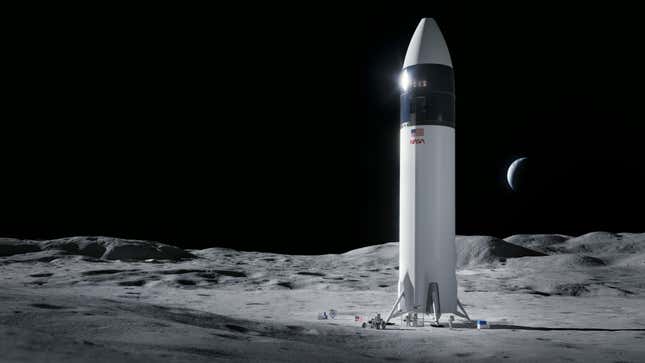
In what is a surprise to absolutely no one, NASA won’t be sending astronauts to the lunar surface in 2024. Blaming everyone but the kitchen sink for the delay, the space agency now intends to send a crew, including a woman and a person of color, to the Moon in 2025.
NASA administrator Bill Nelson broke the news at a press conference held earlier today, but he did so very weirdly.
The federal court decision from last Friday, in which Jeff Bezos’s Blue Origin lost its lawsuit against NASA over the lunar lander contract, “means progress for the Artemis program,” Nelson said, but he then cautioned that NASA is still not ready to disclose timelines for the mission. Nelson then began to discuss timelines for the mission anyway.
The first date on the calendar is already known. Artemis I, in which NASA is supposed to launch its SLS rocket for the first time, is scheduled for February 12, 2022. NASA recently completed the stacking of the rocket, including the mounting of the Orion spacecraft. The 332-foot-tall (101 meter) rocket still needs to undergo some testing, but NASA seems keen to light this candle early in the new year.
Nelson mentioned an approximate date for the Artemis II mission, which will “take astronauts further into space than ever before.” This crewed mission to the Moon and back, sans landing, is now scheduled for May 2023, the previous date being April 2022.
As for the much-anticipated Artemis III mission to land people on the Moon, that will happen at some point in 2025, not 2024 as planned, Nelson said. The revised timelines won’t impact later Artemis schedules, including construction of the Lunar Gateway (a space station in lunar orbit) and various activities planned for the lunar surface in the back half of the 2020s, he added.
That Artemis III won’t happen in 2024 is hardly a surprise, as we’ve been expecting a delay for quite some time. But it was interesting to hear the reasons nonetheless.
“We’ve lost nearly seven months in litigation and that...has pushed the first human [Artemis] landing likely to no earlier than 2025,” Nelson said, in reference to the aforementioned Blue Origin lawsuit. NASA was not permitted under law to communicate with SpaceX until the litigation had ended. That said, SpaceX continued to develop the lunar lander without corresponding with or receiving payments from NASA. It’s not immediately clear what was lost during the seven months of litigation; Nelson and other NASA officials participating in the presser did not disclose any specifics in this regard. Interestingly and perhaps revealingly, Kathy Lueders, leader of NASA’s human spaceflight program, said that, despite NASA being “on hold” due to the Blue Origin lawsuit, “the SpaceX folks have continued to make progress.”
The blame game continued, as Nelson complained that previous Congresses had not appropriated enough money. He also called out the former president, saying the Trump administration’s plan for Artemis “wasn’t grounded in technical feasibility.” Indeed, it was Trump’s idea to launch a crew in 2024 instead of 2028 as originally planned. The covid-19 pandemic, supply chain issues, and damage caused by Hurricane Ida were also cited for the delay (NASA’s Michoud Assembly Facility sustained serious damage in August).
Nelson’s comment about “technical feasibility” is about as close as we’ll ever get to hearing NASA admit technical defeat. The space agency doesn’t like to do that, preferring instead to complain about lack of funding. Blue Origin’s lawsuit may indeed have delayed Artemis, but NASA can hardly blame Bezos for other issues, including the unfinished space suits that, according to a recent Government Accountability Office report, made “a lunar landing in late 2024 ... not feasible.”
NASA Deputy Administrator Pam Melroy provided a fiscal update for Orion, saying the original baseline cost for the spacecraft was $6.7 billion, with the revised estimate now being $9.3 billion. That’s a big jump, but she said “many of the first-time development challenges on SLS and Orion are nearly behind us.”
At the press conference, Nelson also took the opportunity to employ some scare tactics, in a clear attempt to curry favor with Congress. “We are facing a very aggressive and good Chinese space program,” he said. China is becoming “increasingly capable” of landing its Taikonauts on the Moon, an event that could happen “much earlier than expected,” he said. NASA, Nelson declared, is “going to be as aggressive as we can be—in a safe and technically feasible way—to beat our competitors with boots on the Moon.” Nelson warned that the new timelines are contingent on sufficient funding and that Congress needs to increase the NASA budget starting in 2023.
The one-year delay is probably a good thing, as it will likely result in a safer mission. It was also allow more time for NASA to further develop and test those next-gen spacesuits, which will need to keep astronauts protected from the lunar elements. We’ve been waiting for another crewed trip to the Moon since 1972. We can wait another year.